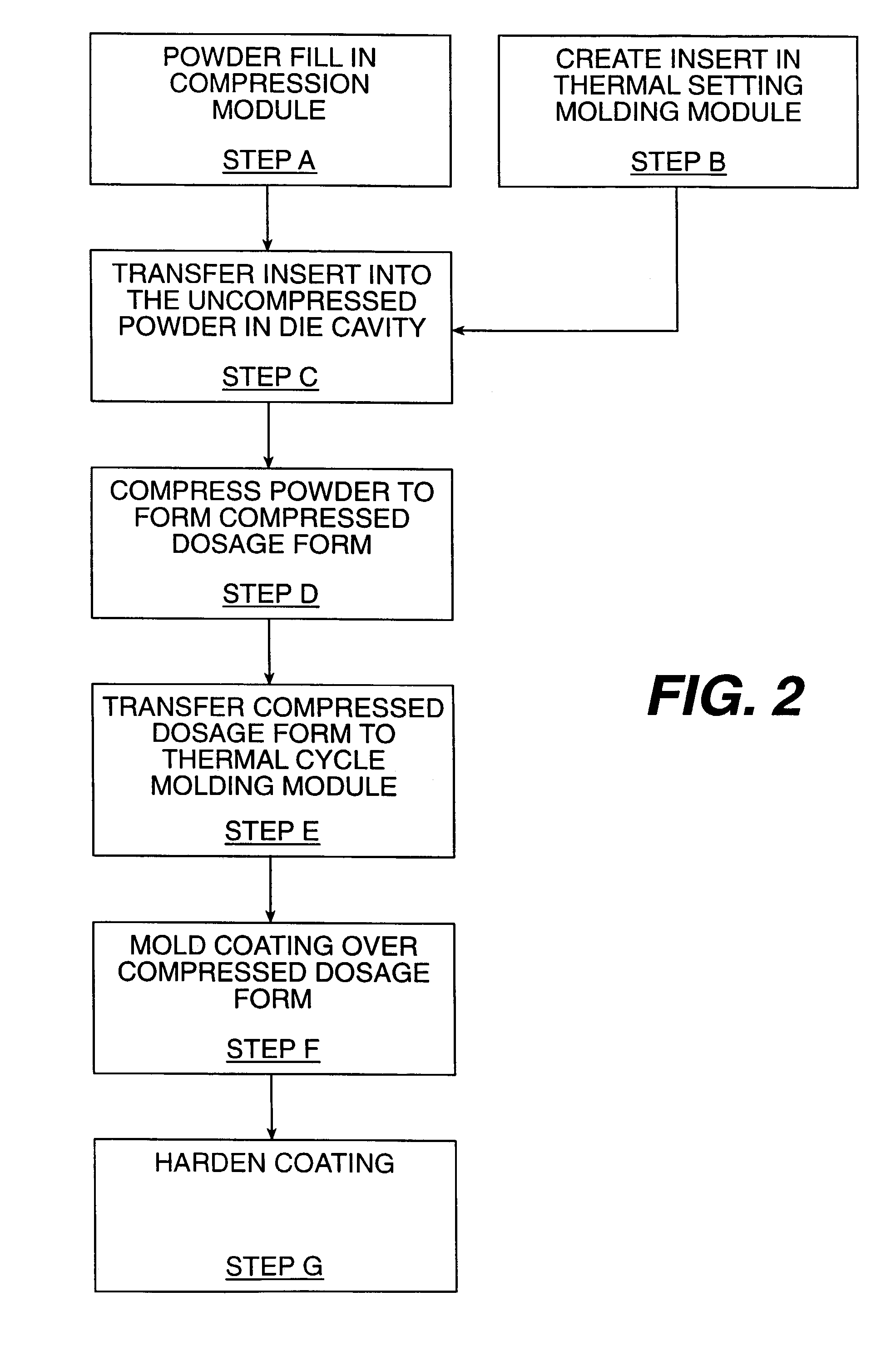Methods for manufacturing dosage forms
a technology of dosage form and manufacturing method, which is applied in the direction of turning machine accessories, drawing profiling tools, macromolecular non-active ingredients, etc., can solve the problems of requiring a relatively large amount of capital in terms of both space and machinery, affecting the quality of the product, etc., to achieve the effect of free visible defects
- Summary
- Abstract
- Description
- Claims
- Application Information
AI Technical Summary
Benefits of technology
Problems solved by technology
Method used
Image
Examples
example 1
[0308]A series of tablets having a molded gelatin coating thereon were made according to the invention as follows.
Part A: Compressed Tablets
[0309]The following ingredients were mixed well in a plastic bag: 89.4 parts acetaminophen USP (590 mg / tablet) and 8.0 parts of synthetic wax X-2068 T20 (53 mg / tablet). Next, 2.1 parts of sodium starch glycolate (EXPLOTAB) (13.9 mg / tablet) and 0.09 parts of silicon dioxide (0.6 mg / tablet) were added to the bag, and mixed well. Then 0.36 parts of magnesium stearate NF (2.4 mg / tablet) were added to the bag, and the ingredients were again mixed. The resulting dry blend was compressed into tablets on a compression module according to the invention using 7 / 16 inch extra deep concave tablet tooling.
[0310]The resulting tablets had an average weight of 660 mg, thickness of 0.306 inches, and hardness of 3.2 kp.
[0311]The tablets from Part A were conveyed to a thermal cycle molding module according to the invention via a transfer device also according to t...
example 2
[0314]Coating thickness was measured for samples of the following tablets:
[0315]A. Extra Strength Tylenol GelTabs
[0316]B. Excedrine Migrane Geltabs
[0317]C. Tablets of produced according to Example 1.
The results are shown in Table 1 below.
[0318]
TABLE 1ABCaverage coating thick-145.17 microns220.40 microns195.37 micronsness at major faces(locations 1, 4) for 6tabletsvariability in coating 10.12% 5.01% 8.79%thickness at majorfaces (locations 1, 4)for 6 tabletsaverage coating thick- 85 microns244.83 microns209.62 micronsness (locations 1–6 for6 tablets)coating thickness var- 52.71% 12.64% 18.49%iability (rsd for loca-tions 1–6 for 6 tablets)average coating thick- 54.92 microns257.05 microns216.74 micronsness at edgescoating thickness var- 19.80 11.88 20.56iability at edges (rsdfor locations 2, 3, 5, 6for 6 tablets)average difference in 63.25% 16.99% 15.93%coating thickness be-tween major face andedge (location 1–loca-tion 2, location 4–loca-tion 5)maximum difference 72% 33.4% 40.6%in...
example 3
[0320]Compressed tablets were prepared according the method described in Example 1. Press settings were held constant for a period of 7 hours, 47 minutes. Tablets were sampled every 15 minutes. The resulting tablets had the following properties:
[0321]
Weight (mg) (average):603.5Weight (mg) (minimum):582.2Weight (mg) (maximum):615.2Weight (relative standard deviation (%))1.619Thickness (inches) (average):0.293Thickness (inches) (minimum):0.29Thickness (inches) (maximum):0.30Thickness (relative standard deviation (%))1.499Hardness (kp) (average):1.713Hardness (kp) (minimum):1.12Hardness (kp) (maximum):3.16Hardness (relative standard deviation (%))21.8
PUM
| Property | Measurement | Unit |
|---|---|---|
| linear velocity | aaaaa | aaaaa |
| diameter | aaaaa | aaaaa |
| diameter | aaaaa | aaaaa |
Abstract
Description
Claims
Application Information
 Login to View More
Login to View More - Generate Ideas
- Intellectual Property
- Life Sciences
- Materials
- Tech Scout
- Unparalleled Data Quality
- Higher Quality Content
- 60% Fewer Hallucinations
Browse by: Latest US Patents, China's latest patents, Technical Efficacy Thesaurus, Application Domain, Technology Topic, Popular Technical Reports.
© 2025 PatSnap. All rights reserved.Legal|Privacy policy|Modern Slavery Act Transparency Statement|Sitemap|About US| Contact US: help@patsnap.com



